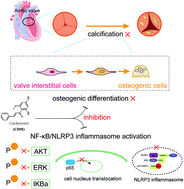Cardamonin inhibits osteogenic differentiation of human valve interstitial cells and ameliorates aortic valve calcification via interfering in the NF-κB/NLRP3 inflammasome pathway†
Abstract
Cardamonin (CDM) is a natural chalcone with strong anti-inflammatory properties. Inflammation-induced osteogenic changes in valve interstitial cells (VICs) play crucial roles in the development of calcific aortic valve disease (CAVD), a degenerative disease characterized by degeneration, thickening, fibrosis, and calcification of the heart valve tissues. To investigate the anti-osteogenic differentiation role of CDM in human valve interstitial cells (hVICs), which consequently reverses the calcification of the aortic valve, human VICs were exposed to osteogenic induction medium (OM) with CDM for further cell viability, osteogenic gene and protein expression analyses, and anti-calcification testing. mRNA sequencing was utilized to analyze the differentially expressed genes (DEGs) and related signaling pathways as potential molecular targets involved in CDM's anti-calcification activity. Human aortic valve leaflet ex vivo calcific cultures were used to investigate the CDM inhibition of osteogenic differentiation of hVICs at the tissue level. ApoE−/− mice fed with a high-fat (HF) diet were used to evaluate the effect of CDM on aortic valve calcification. No significant CDM cytotoxicity was seen in the hVICs at 10 μM. The addition of CDM to OM prevented calcified nodule accumulation, and a decrease in the gene/protein expression levels of BMP2, RUNX2, SPP1, TNF-α, and COL1A2 was observed. Venn diagram analysis of the DEGs identified 666 common DEGs and highlighted the NOD-like receptor signaling pathway (ko04621) as an anti-calcification target of CDM. CDM also repressed the activation of p-AKT, p-ERK1/2, and p-IκBα, and prevented the OM-induced nuclear transcription of NF-κB p65. In the in vitro and ex vivo calcific conditional culture experiments, CDM exhibited anti-inflammatory and anti-calcification effects by suppressing the activation of the NLRP3 inflammasome and downregulating IL-1β expression. In vivo, CDM ameliorated aortic valve calcification by interfering with NLRP3 expression. Our study demonstrated that CDM inhibited the phenotypical calcific transformation of hVICs by mediating the inactivation of the NF-κB/NLRP3 inflammasome. Therefore, it is considered to be a promising natural compound for use in preventing the progression of heart valve calcification disease.



 Please wait while we load your content...
Please wait while we load your content...